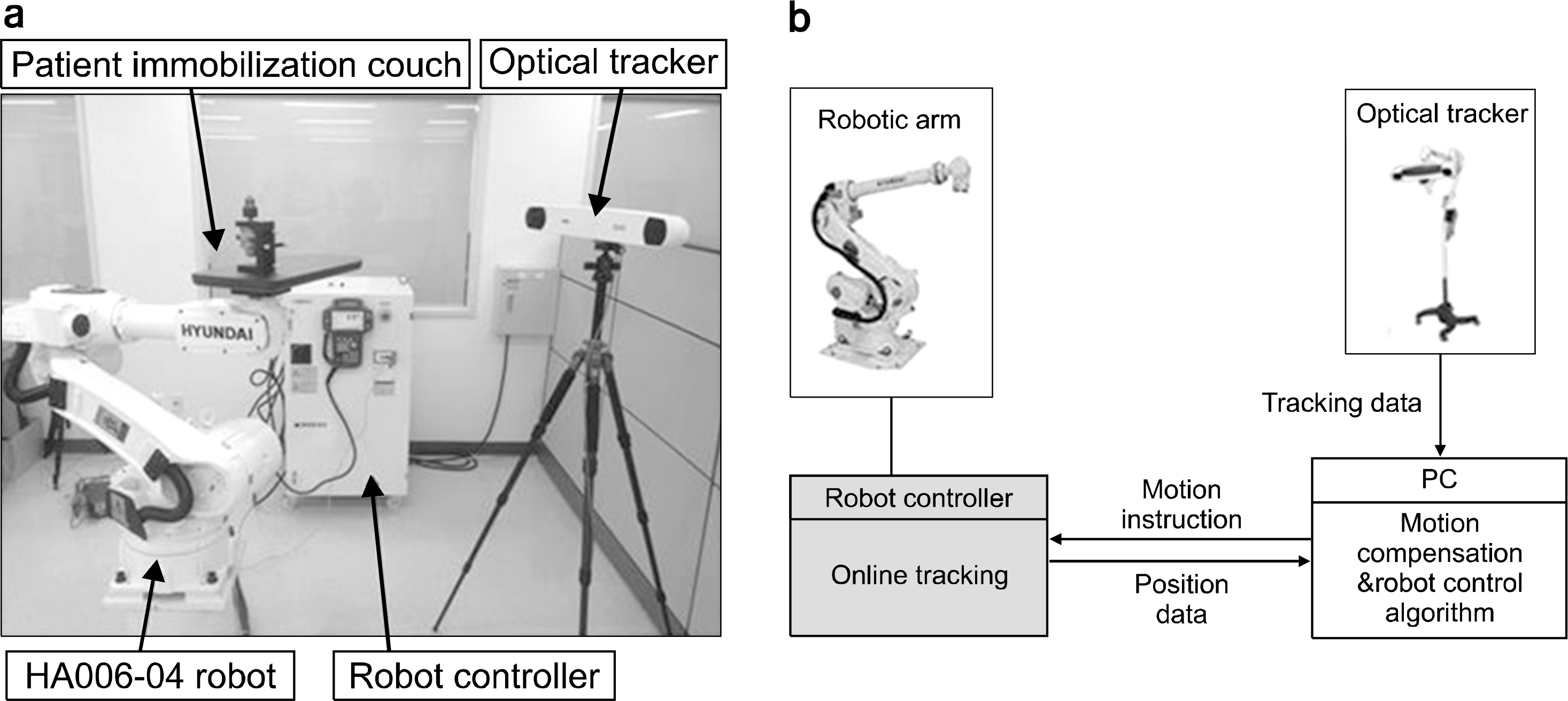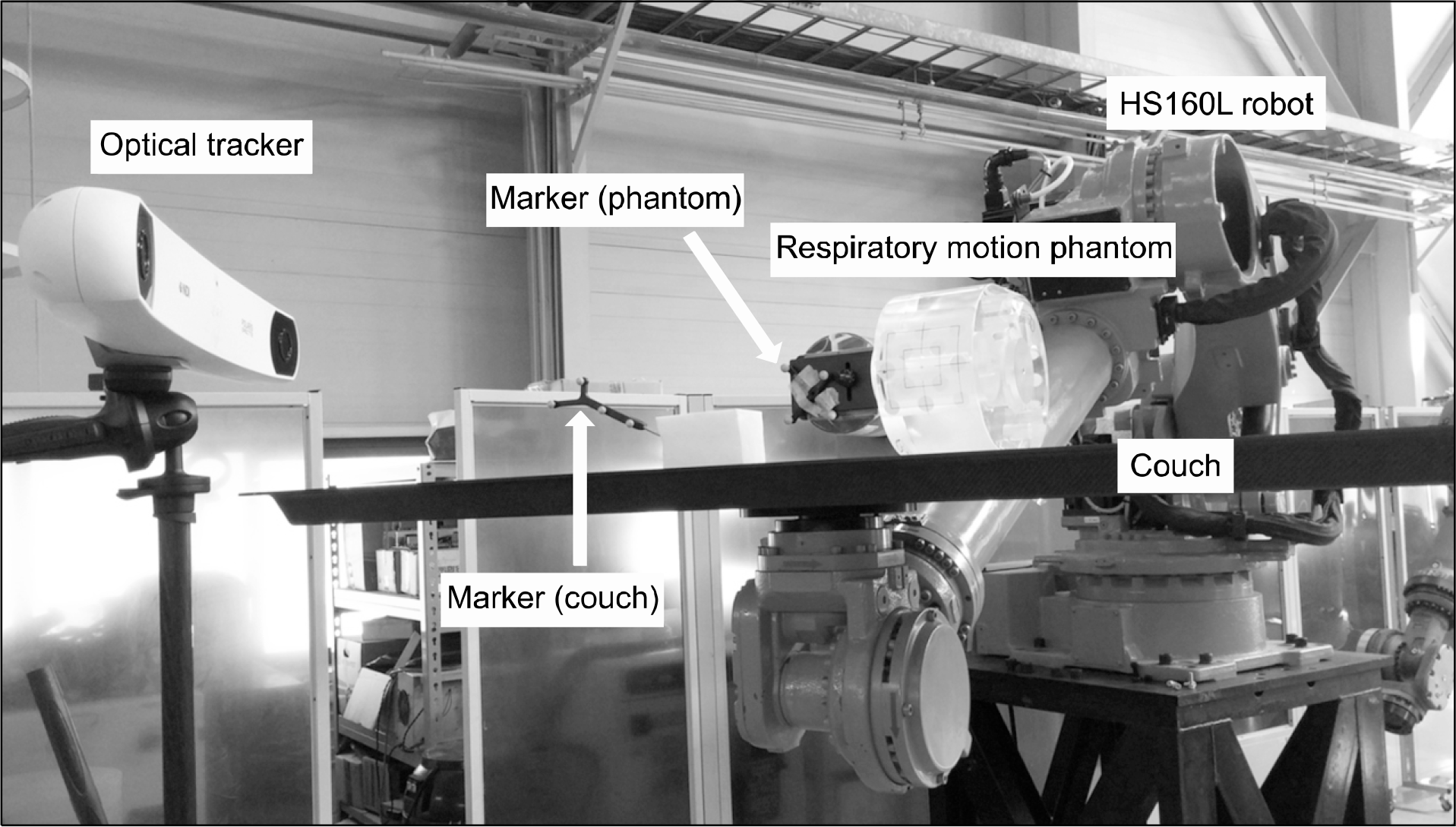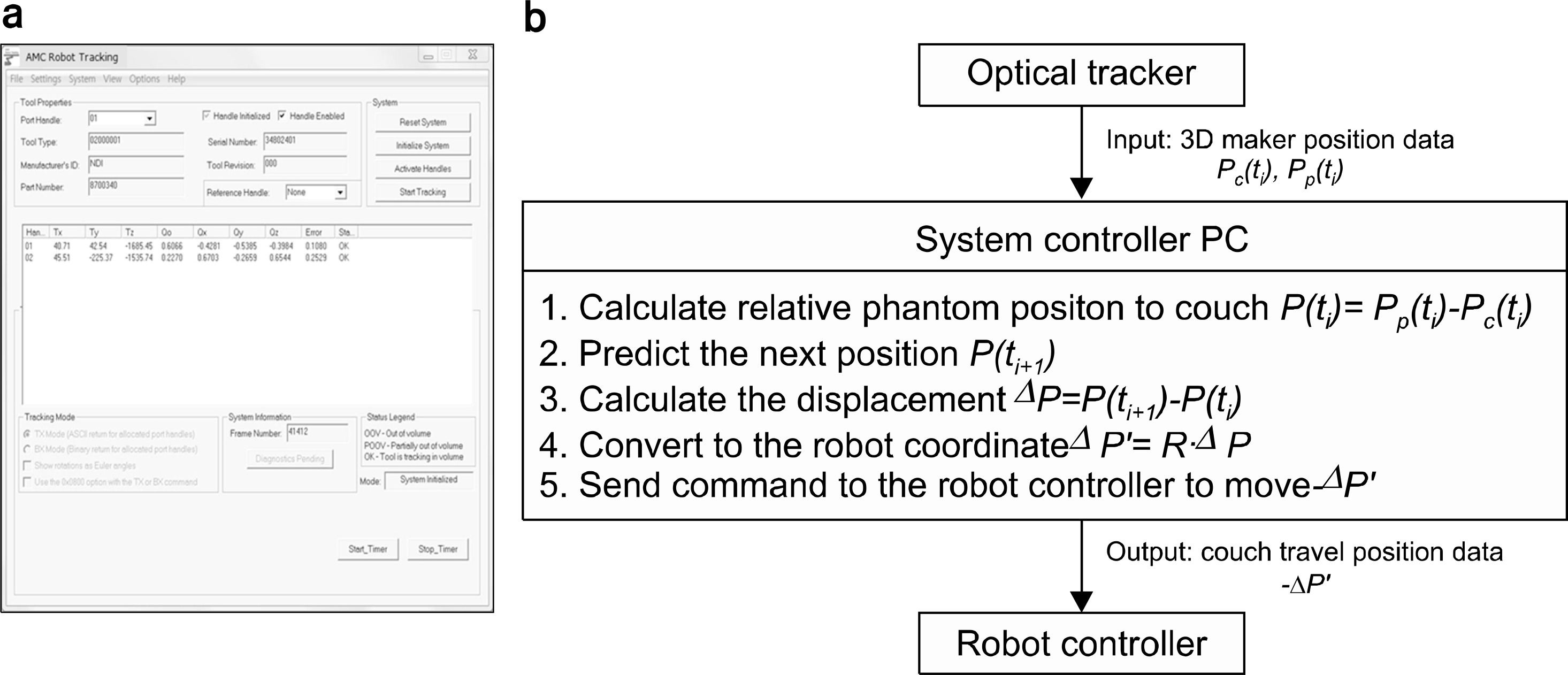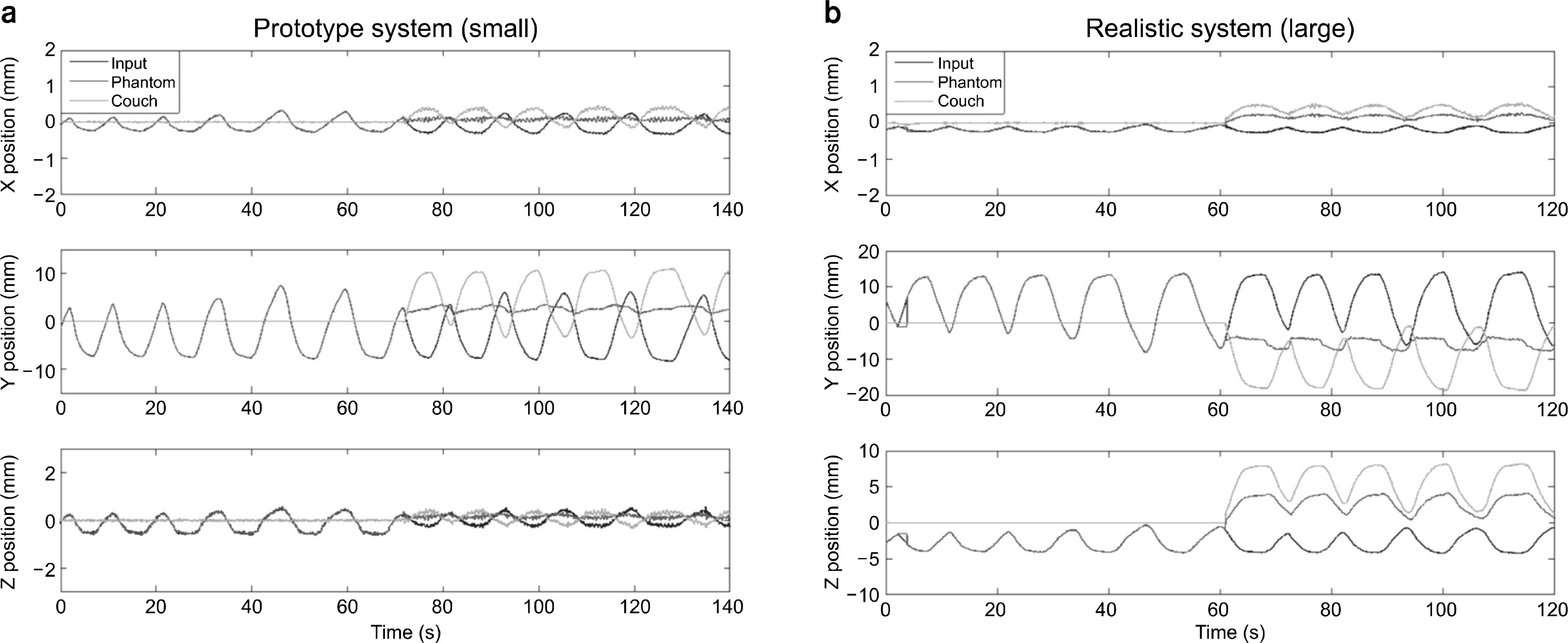Abstract
Intrafractional motion of patients, such as respiratory motion during radiation treatment, is an important issue in image-guided radiotherapy. The accuracy of the radiation treatment decreases as the motion range increases. We developed a control system for a robotic patient immobilization system that enables to reduce the range of tumor motion by compensating the tumor motion. Fusion technology, combining robotics and mechatronics, was developed and applied in this study. First, a small-sized prototype was established for use with an industrial miniature robot. The patient immobilization system consisted of an optical tracking system, a robotic couch, a robot controller, and a control program for managing the system components. A multi speed and position control mechanism with three degrees of freedom was designed. The parameters for operating the control system, such as the coordinate transformation parameters and calibration parameters, were measured and evaluated for a prototype device. After developing the control system using the prototype device, a feasibility test on a full-scale patient immobilization system was performed, using a large industrial robot and couch. The performances of both the prototype device and the realistic device were evaluated using a respiratory motion phantom, for several patterns of respiratory motion. For all patterns of motion, the root mean squared error of the corresponding detected motion trajectories were reduced by more than 40%. The proposed system improves the accuracy of the radiation dose delivered to the target and reduces the unwanted irradiation of normal tissue.
REFERENCES
1.Timmerman RD. Surgery versus stereotactic body radiation therapy for early-stage lung cancer: Who's down for the count? J Clin Oncol. 28(6):907–909. 2010.

2.Keall PJ., Mageras GS., Balter JM, et al. The management of respiratory motion in radiation oncology report of AAPM Task Group 76. Med Phys. 33(10):3874–3900. 2006.
3.Ohara K., Okumura T., Akisada M, et al. Irradiation synchronized with respiration gate. Int J Radiat Oncol Biol Phys. 17(4):853–857. 1989.

4.Kubo HD., Hill BC. Respiration gated radiotherapy treatment: a technical study. Phys Med Biol. 41(1):83–91. 1996.

5.Ford EC., Mageras GS., Yorke E., Rosenzweig KE., Wagman R., Ling CC. Evaluation of respiratory movement during gated radiotherapy using film and electronic portal imaging. Int J Radiat Oncol Biol Phys. 52(2):522–531. 2002.

6.Vedam SS., Keall PJ., Kini VR., Mohan R. Determining parameters for respiration-gated radiotherapy. Med Phys. 28(10):2139–2146. 2001.

7.Schweikard A., Shiomi H., Adler J. Respiration tracking in radiosurgery. Med Phys. 31:2738–2741. 2004.

9.Keall PJ., Kini VR., Vedam SS., Mohan R. Motion adaptive X-ray therapy: a feasibility study. Phys Med Biol. 46(1):1–10. 2001.

10.Cho B., Poulsen PR., Sawant A., Ruan D., Keall PJ. Real-time target position estimation using stereoscopic kilovoltage/megavoltage imaging and external respiratory monitoring for dynamic multileaf collimator tracking. Int J Radiat Oncol Biol Phys. 79(1):269–278. 2011.

11.Fledelius W., Keall PJ., Cho B, et al. Tracking latency in image-based dynamic MLC tracking with direct image access. Acta Oncol. 50(6):952–959. 2011.

12.Poulsen PR., Cho B., Sawant A., Keall PJ, et al. Implementation of a new method for dynamic multileaf collimator tracking of prostate motion in arc radiotherapy using a single kV imager. Int J Radiat Oncol Biol Phys. 76(3):914–923. 2010.

13.Depuydt T., Poels K., Verellen D., Engels B, et al. Treating patients with real-time tumor tracking using the Vero gimbaled linac system: implementation and first review. Radiother Oncol. 112(3):343–51. 2014.

14.Lee S., Chang KH., Shim JB., Cao Y, et al. Evaluation of mechanical accuracy for couch-based tracking system (CBTS). J Appl Clin Med Phys. 13(6):157–169. 2012.

15.D'Souza WD., Naqvi SA., Yu CX. Real-time intra-fraction- motion tracking using the treatment couch: a feasibility study. Phys Med Biol. 50(17):4021–33. 2005.
16.Olch AJ., Gerig L., Li H., Mihaylov I., Morgan A. Dosimetric effects caused by couch tops and immobilization devices: report of AAPM Task Group 176. Med Phys. 41(6):061501–1. -30. 2014.

Fig. 1
(a) Prototype of the patient immobilization system consisting of a robotic arm, a couch, a robot controller, an optical tracker, and a camera. (b) Schematic of the motion compensation system.

Fig. 2
Real-scale patient immobilization system for evaluating the motion compensation performance with respect to the respiration-associated motion.

Fig. 3
(a) Screenshot of the in-house motion detection and control program running on the system control PC. (b) Algorithm flow chart of the developed motion compensation system. Pc(ti) and Pp(ti) are 3D positions of the marker on the couch and the marker on the motion phantom at time ti. R is the coordinate transformation matrix, from the optical tracker system of coordinates to the robot system of coordinates.

Fig. 4
3D position data measured by the optical tracker, for markers attached to the motion phantom and couch. The typical-slow respiratory motion pattern was considered here. (a) Results obtained for the prototype system. (b) Results obtained for the real-scale system. The motion compensation was initiated about halfway into the measurement period.

Table 1.
Mechanical specifications and limitations of the two robot manipulators used in this study.
Table 2.
Calibration errors between the input positions to the robot and the measured positions.
| Point number | Error (mm) |
|---|---|
| 1 | 0.07 |
| 2 | 0.10 |
| 3 | 0.08 |
| 4 | 0.07 |
| 5 | 0.10 |
| 6 | 0.08 |
| 7 | 0.10 |
| 8 | 0.06 |
| Average | 0.08 |
Table 3.
Input position data provided to the robot and the measured positions in the robotic coordinate system.
Table 4.
3D RMSEs, before and after applying the motion compensation, and the reduction ratios of the 3D RMSEs for seven motion patterns measured using the small-scale prototype device.
Table 5.
3D RMSEs, before and after applying the motion compensation, and the reduction ratios of the 3D RMSEs for three motion patterns measured using the real-scale device.
| Motion pattern | 3D RMSE | 3D RMSE (Compensated) | Error reduction ratio (%) |
|---|---|---|---|
| Typical | 5.63 mm | 2.95 mm | 47.7 |
| Typical-slow | 6.54 mm | 1.77 mm | 72.9 |
| Irregular | 3.94 mm | 2.35 mm | 40.4 |




 PDF
PDF ePub
ePub Citation
Citation Print
Print


 XML Download
XML Download